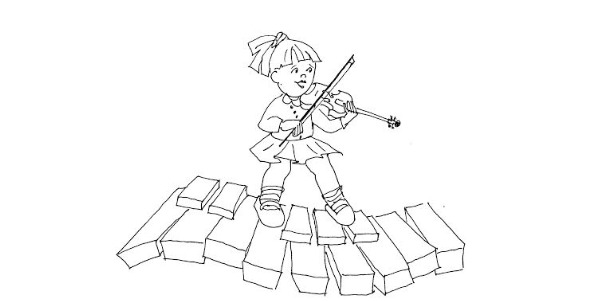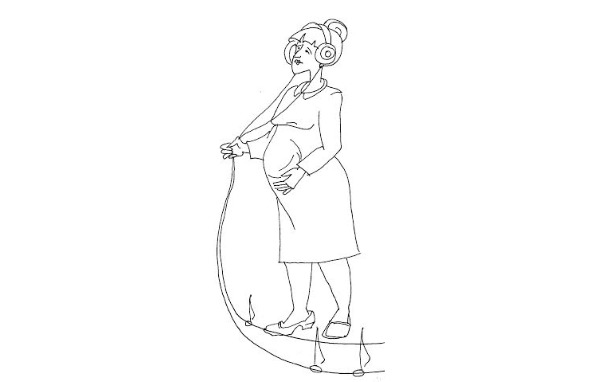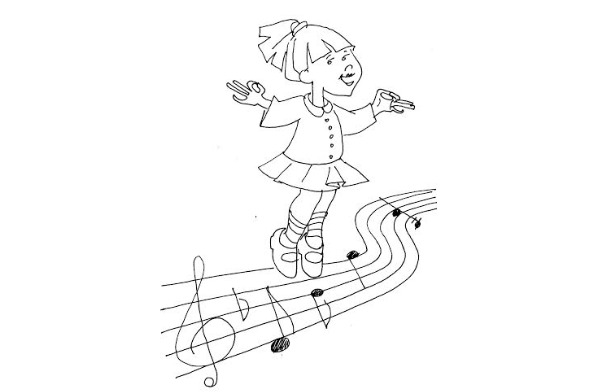
Бесплатный фрагмент - Suzuki Sounds
Or author’s manual for caring parents
Introduction
“Man is a son of his environment”
Shinichi Suzuki
Talent is an amazing and marvelous phenomenon. All mothers in the world want their children to become successful! And talent allows you to stand out from the crowd. But to have talent or ability is only part of the Big Prize! And for true success, you still need the right environment and luck. We are all different, and each of us is talented in our own way. Unfortunately, not everyone manages to demonstrate their abilities in life. And throughout their whole life a person can think that they were born without any special abilities.
But Dr. Suzuki found a simple yet brilliant way to expose talent in every child. His method is also called the “Native Language Method”. From a very young age children learn to play musical instruments as naturally as they learn to speak their native language. After all, music is also a language. And all children, sooner or later, learn to speak their mother’s language, no matter how difficult it is. This is facilitated by life itself: the child is surrounded by close people who speak their native language, feels protected, constantly listens and imitates. That’s all!
“Talent is no accident of birth”, “Talent is not inborn, it has to be created” –was these statements are the essence of the wonderful method of the great Japanese teacher-musician. Every child can learn to play musical instruments, just as they can walk, talk and read. It all depends on the people with whom they are surrounded by. And if the child’s abilities were not developed at the most suitable time for this — from 0 to 5 years, then you shouldn’t settle for this for the future. It is necessary to work on yourself and achieve more!
Music is still one of the most proven ways to develop children. This method has not changed! This art is understandable to every person: it inspires people to create poems, novels, paintings and sculptures. Many scientific discoveries that became a breakthrough in the history of mankind would not have happened without musical art! We have heard scientists’ names who were outstanding musicians: chemists Alexander Butlerov and Alexander Borodin, physicists Jacob Frenkel and Max Planck, constructor Lev Termin and many others.

“Music and research in the field of physics are different in origin, but are interconnected by a unity of purpose — the desire to express the unknown.” These words belong to the great scientist and violinist Albert Einstein. As they say, no comment! Numerous modern scientific studies have proven that playing music seriously affects the human brain. Mathematical abilities and speech are developed, thought processes are activated, and short-term memory and intuition are improved.
All of the above, in addition to standard skills are: the development of hearing and voice, movement coordination and auditory perception. But this “useful” list does not end there. Under the influence of playing music, the psycho-emotional state improves, memory disorders, Alzheimer’s disease, insomnia are treated, and patients are rehabilitated after strokes and craniocerebral injuries. A truly amazing, unique mechanism is right in our hands!
Why then do we so rarely witness positive results in children who diligently attend music schools? And why do many children, having received such an education, do not then touch their instruments, do not play music for their pleasure? Why is teaching children a fine art sometimes becomes not due to, but contrary to? Probably because this system works too selectively and is not intended for everyone. It is great for discovering and nurturing rare natural talents. But now, time and children have changed. And we began to seek for other techniques.
I, as a teacher who has worked in the children’s music school for more than 10 years, am well acquainted with this “offensive” situation for the teacher. And I have also asked myself many questions:
— Why do children get so tired of school so quickly?
— Why do they learn from under the parental “stick”?
— Why do creativity and freedom disappear from music lessons?
I searched and tried various systems in working with children and unexpectedly stumbled upon the technique of Japanese violinist-teacher, Shinichi Suzuki. My soul immediately responded!
The method turned out to be far from new, but it has long been tried and tested in many countries over the world, from the 1950s.
About Suzuki and his method
“A child’s slowness in any subject indicates a deficiency in his environment, educational or otherwise,” -Suzuki argued. The participation of one of the parents in the educational process is mandatory. Without them, the miracle of mastering the native language does not happen! Toddlers under 5 learn mostly from their parents. They don’t need peers, but parents are really needed. If adults are interested, if they are passionate, then the child will be interested. This process brings them together, unites the whole family. This method is not about learning to play an instrument. This method is about communication and exchange of positive energies, support and care for each other. In short: the Suzuki system works perfectly for family cohesion. Families involved in the Suzuki method stand out from the others. I see more positive relations between parents and children, and a lot of progress in development. Because everyone is involved in the learning process. And everyone who is in it is there voluntarily showing interest and participation. Sometimes, I get really upset knowing that I didn’t expose music to my daughter according to the Suzuki method.
I just took her to a music school, to a good teacher, hoping for a result. Unfortunately, I had no other options; I didn’t know anything about the magical method of the great Japanese teacher back then. The result could have been very different…
Dr. Suzuki lived a long and extraordinary life. He was born in Nagoya in 1898, in a big family with twelve children. His father owned a violin factory. The boy spent his whole childhood in there, watching the process and helping his father. However, he had no intentions of becoming a musician. At the age of 17, when he first heard Schubert’s “Ave Maria”, the young man was deeply shocked by the performance of the then-famous violinist Misha Elman, and began to independently learn to play the violin by ear. He worked hard, took private lessons and demonstrated remarkable abilities. At the age of 20, Suzuki went on a world tour with Prince Tokugawa, who convinced the young man and his father to take a course at the Berlin Conservatory.
Shinichi Suzuki lived in Germany for 8 years, studying the art of playing violin with Professor Karl Klinger. At this time, he met Albert Einstein, who was also an amateur violinist. They quite often played music together. During the training, Suzuki became deeply acquainted with the work of Mozart, who then became his favorite composer for life. In 1930, Suzuki returned to Japan with his wife.
He began teaching at the Imperial School of Music in Tokyo. Over the years, he was able to accumulate rich pedagogical experience, which allowed him to further create his own method of “Education of talents”.
During the Second World War, the Suzuki family suffered many losses: the father’s factory was destroyed, one of his brothers was killed, his family was left with no means. To survive, he began giving lessons to orphans. Many children were very young, Koji Toyoda began to play the violin when he was only 3.5 years old. He became one of the first students who Dr. Suzuki taught engaging his own method.
Mr. Toyoda is the current President of the International Suzuki Association, which he inherited after the death of his teacher in 1998. Gradually, the method and successful work with young children became widely known, and in 1945 Suzuki opened his own school in Matsumoto, a suburb of Nagano. Over time, the school turned into the Suzuki Talent Education Institute, which successfully operates today. In this educational institution, both children and future teachers study. The first international fame came in 1953, when the French poet and critic Georges Duvel published an article “An Ideal Childhood” in which he talked about a concert by young violinists, taught by Suzuki, that he attended during his trip to Japan.
In 1961 the great Spanish cellist, conductor and composer Pablo Casals visited a concert which involved 400 young violinists in Tokyo. The talent of Suzuki’s students led the maestro to complete delight. He was amazed by the live results of the Shinichi Suzuki training. This way, the people in Europe and America gradually became aware of this method. After Suzuki’s children’s ensemble toured in the United States in 1964, the rapid spread of his system around the world initiated. The International Suzuki Associations were founded, and the training of teachers for further teaching began. Now, it’s possible to practice according to the Suzuki method in almost any country in the world: there are 55 national organizations, more than 8000 various instrumental teachers, and more than 250,000 children have learned to play instruments using this system. Suzuki’s philosophy is rightfully gaining more and more adherents.
What is so unusual about these music classes, you may ask? What’s the secret? The genius of Suzuki lies in the fact that he understood the universality of the relationship between “mother language” for the child and musical art. And many years of practice have confirmed that this path is the most faithful and effective.
The path of not coercion, but of growing and unleashing the potential built-in by nature. What is needed for this? Nothing special, just to follow certain teaching principles. There are not many of them, but the system does not work if one is missing:
• The child should be in a positive environment, parents should actively participate in activities and support kid’s interest in knowledge. Parents themselves should be an example for their children in the desire to develop and learn new things;
• Children should listen to excellent music daily at home. Listening creates a learning atmosphere for the student, the learning process is easier and faster;
• Mandatory repetitions and daily work on errors. Repetition, the mother of learning, has not been canceled! Without multiple repetitions it is impossible to achieve a performance;
• Early start! The earlier the better. Each child develops according to their own individual plan;
• Mandatory group lessons where children can learn to listen to others and play in an ensemble.
For over 70 years, these rules of the Suzuki method have been helping to uncover the talents of children around the world. Nevertheless, the method is not aimed at “creating” geniuses, but at raising good and noble people, developing discipline, hard work, memory, concentration, and understanding of beauty in children. “Character first, ability second”. I think each of us will agree with this. These qualities are fundamental to the personality of a modern person — Homo Evolution.

When to start learning?
You are definitely late if you first thought about this question after the birth of a child! The best time to start is prenatal and although these words may sound crazy to some parents, in support of this statement I want to share my personal experience.
I started working with my daughter even before she was born. For this purpose, I chose sounds — the voices of my family and music. During pregnancy, I constantly went to the opera and concerts, because I am a musician myself and try to attend good performances. A month before giving birth, I listened to an opera by Rigoletto Verdi at the Hermitage Theater, performed by Dmitry Hvorostovsky. To this day I cannot forget his brilliant performance. The acoustics there are excellent, so my daughter also heard the opera well inside me. With a high degree of probability, I can say that thanks to this 9-month intrauterine training, she has developed excellent hearing.
During pregnancy, I studied a bunch of early development books. The thought of developing a child from birth completely captured me. As a result, I chose the methodology of the American psychologist and physician Glen Doman. His books “Harmonious Development of a Child” and “How to Teach Your Child to Read” became for me the textbooks I used for the development of my daughter from birth. Doman’s technique was truly revolutionary at one time, and even now it has not lost its relevance. In the 60s and 90s, on its basis, more modern developmental systems of the Japanese teachers Makoto Shichida and Heguru appeared. By the way, Suzuki was well acquainted with Doman’s theory, and shared his opinion about the great potential of young children and the need for an early start.
The Suzuki Method also targets this. Children start playing instruments at 2—3 years old. Before that, sometimes right from birth, they are engaged in preparatory groups for early development with their mothers and sometimes with younger brothers and sisters. And practice testifies: the process of subsequent education of younger children that had previously been “passively” trained by the Suzuki method proceeds much faster and better.
Why is it important to start learning from an early age? Children learn to walk, eat and speak their native language on their own until they are 3 years old. At this age, the human brain is like a sponge that absorbs a huge amount of information at great speed. This process gradually slows down as the time goes. Therefore, the sooner you start learning music, the more natural and easier it will be. In my baby’s cot there were signs with drawn letters and words, we did dynamic gymnastics and went swimming in the pool, we would listen to classical music every day. She first walked when she was 9 months old, started talking when she was 1.5 years old, and she did so at once in whole sentences. From that time on, we started learning English. My daughter attended a private kindergarten with teachers who were native speakers, in order to be fully immersed in the atmosphere of a foreign language. Such kindergartens are now commonplace. In the early 2000s though, only a few people understood my actions. But thanks to such an early and active study of the English language, my daughter has almost no accent now. And she is terribly proud of it!
At the time, I didn’t think about the results. I only wanted my child to know and be able to do a lot. It is now clear that the main reason for this parental zeal was my ambition. But is it always bad for a child? If the goal of the effort is to gain new useful knowledge and to expand the abilities of the individual, and not to foolishly compete with other people, then I’m sure it is not!
And another important detail: I dedicated a lot of time to intercommunicating. I even wrote funny stories about two funny friends Bunny and Bear, like my favorite fairy tale about Homa and Gopher from childhood. They were informative and edifying and my daughter loved to listen to them. Together we would occasionally come up with a sequel to them. I wish I wrote them down! It would make a whole series.
At the age of 13, we had already tried different activities: ice skating, skiing, swimming, tennis, chess, equestrian sports, drawing and playing the piano. We always had a tough schedule to get everything done. And such regime taught my daughter responsibility and independence. Now that she lives on campus alone, these skills help her a lot. All these activities have borne fruit and influenced my daughter’s abilities, habits and character. Without my parental conviction and perseverance, without constant guardianship and support, this would hardly have happened! Concluding this chapter, I want to say once again: everything that you put into your child will not disappear without a trace. Be sincere in your feelings, believe in yourself and in your talented children.

How to start practicing?
To start making music using the Suzuki Method, you must first select a teacher who is officially licensed to teach the Suzuki method. This is a very important and crucial moment since there are still not many Suzuki teachers in Russia. There are several reasons for this: the method is not widely known in our country, it is quite expensive, and the teachers need to spend a lot of effort, money and time to study it. To be honest, you need to be a real enthusiast and professional in order to start learning again and to completely change your teaching philosophy and pedagogical skills. Therefore, it is important for parents to know that the teacher is indeed a member of the national Suzuki Association and has a decent reputation.
Бесплатный фрагмент закончился.
Купите книгу, чтобы продолжить чтение.